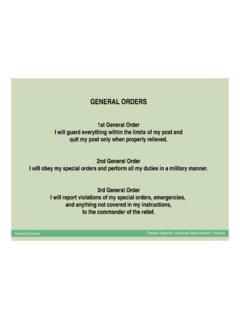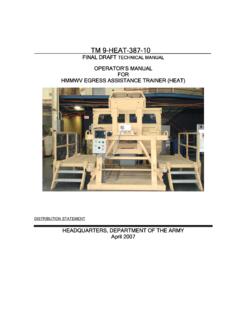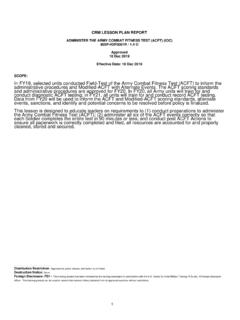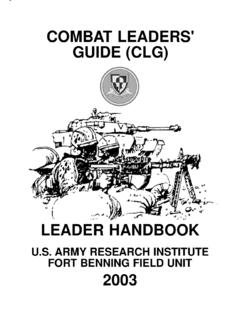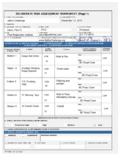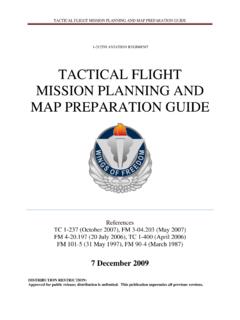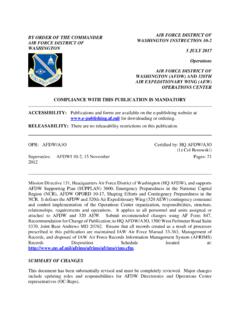Transcription of Commander and Staff Organization and Operations
1 Change No. 2FM 6-0, C2 Headquarters Department of the Army Washington, DC, April 2016 Commander and Staff Organization and Operations 2 to FM 6-0, 5 May 2014, updates discussion of evaluation criteria, corrects errors in how toweight evaluation criteria, and makes administrative left-pointing triangle ( ) marks new content 6-0, 5 May 2014, is changed as follows:Remove Old Pages Insert New Pages pages 9-1 through 9-46 pages 9-1 through 9-46pages References-1 through References-4 pages References-1 through References-4 this transmittal sheet in front of the publication for reference RESTRICTION: Approved for public release; distribution is unlimited.
2 By Order of the Secretary of the Army 0$5. $ 0,//(<General, United States ArmyChief of Staff Official:GERALD B. O KEEFEA dministrative Assistant to the Secretary of the Army1610404 DISTRIBUTION:Active Army, Army National Guard, and United States Army Reserve: 7R EH Gistributed in DFFRUGDQFH ZLWK WKH LQLWLDO GLVWUXEXWLRQ QXPEHU ,'1 116056 UHTXLUHPHQWV IRU FM 6-0 )0 & $SULO PIN: 104216-00222 April 2016FM 6-0, C2 9-1 Chapter 9 The Military Decisionmaking Process The military decisionmaking process is one of the Army s three planning methodologies. Before beginning an iteration of the military decisionmaking process, readers should review chapter 2 of ADRP 5-0 to understand the fundamentals of planning.
3 This chapter defines and describes the characteristics of the military decisionmaking process. Next, it provides a detailed discussion of each step of the military decisionmaking process. The chapter concludes by providing guidance for conducting the military decisionmaking process in a time-constrained environment. Effectively conducting the military decisionmaking process requires leaders who understand the fundamentals of planning. CHARACTERISTICS OF THE MILITARY DECISIONMAKING PROCESS 9-1. The military decisionmaking process is an iterative planning methodology to understand the situation and mission, develop a course of action, and produce an operation plan or order (ADP 5-0).
4 The military decisionmaking process (MDMP) helps leaders apply thoroughness, clarity, sound judgment, logic, and professional knowledge to understand situations, develop options to solve problems, and reach decisions. This process helps commanders, staffs, and others think critically and creatively while planning. 9-2. The MDMP facilitates collaborative planning. The higher headquarters solicits input and continuously shares information concerning future Operations through planning meetings, warning orders, and other means. It shares information with subordinate and adjacent units, supporting and supported units, and unified action partners.
5 Commanders encourage active collaboration among all organizations affected by pending Operations to build a shared understanding of the situation, participate in course of action development and decisionmaking, and resolve conflicts before publishing the plan or order. 9-3. During planning, assessment focuses on developing an understanding of the current situation and determining what to assess and how to assess progress using measures of effectiveness and measures of performance. Developing the unit s assessment plan occurs during the MDMP not after developing the plan or order. (See chapter 15 for details on assessment plans.)
6 9-4. The MDMP also drives preparation. Since time is a factor in all Operations , commanders and staffs conduct a time analysis early in the planning process. This analysis helps them determine when to begin certain actions to ensure forces are ready and in position before execution. This may require the Commander to direct subordinates to start necessary movements, conduct task Organization changes, begin information collection, and execute other preparation activities before completing the plan. As the Commander and Staff conduct the MDMP, they direct preparation tasks in a series of warning orders (WARNORDs).
7 9-5. Depending on the situation s complexity, commanders can initiate the Army design methodology before or in parallel with the MDMP. If the problem is hard to identify or the operation s end state is unclear, commanders may initiate Army design methodology before engaging in detailed planning. Army design methodology can assist the Commander and Staff in understanding the operational environment, framing the problem, and considering an operational approach to solve or manage the problem. The understanding and products resulting from Army design methodology guide more detailed planning during the MDMP. When used in parallel, the Commander may direct some Staff members to conduct mission analysis while engaging others in Army design methodology activities prior to course of action development.
8 Results of both mission analysis and Army design methodology inform commanders in Chapter 9 9-2 FM 6-0, C2 22 April 2016development of their Commander s intent and planning guidance. In time-constrained conditions, or when the problem is not complex, commanders may conduct the MDMP without incorporating formal Army design methodology efforts. During execution, the Commander can use Army design methodology to help refine understanding and visualization as well as assessing and adjusting the plan as required. THE SEVEN STEPS OF THE MILITARY DECISIONMAKING PROCESS9-6. The MDMP consists of seven steps, as shown in figure 9-1. Each step of the MDMP has various inputs, a step to conduct, and outputs.
9 Each step also has a series of processes that commanders and staffs conduct to produce the outputs. The outputs lead to an increased understanding of the situation, facilitating the next step of the MDMP. Commanders and staffs generally perform these steps sequentially; however, they may revisit several steps in an iterative fashion as they learn more about the situation before producing the plan or order. 9-7. Commanders initiate the MDMP upon receipt of, or in anticipation of, a mission. Commanders and staffs often begin planning in the absence of a complete and approved higher headquarters operation plan (OPLAN) or operation order (OPORD). In these instances, the headquarters begins a new planning effort based on a WARNORD and other directives, such as a planning order or an alert order from its higher headquarters.
10 This requires active collaboration with the higher headquarters and parallel planning among echelons as the plan or order is developed. THE ROLE OF COMMANDERS AND STAFFS IN THE MILITARY DECISIONMAKING PROCESS9-8. The Commander is the most important participant in the MDMP. More than simply decisionmakers in this process, commanders use their experience, knowledge, and judgment to guide Staff planning efforts. While unable to devote all their time to the MDMP, commanders follow the status of the planning effort, participate during critical periods of the process, and make decisions based on the detailed work of the Staff . During the MDMP, commanders focus their activities on understanding, visualizing, and describing.
